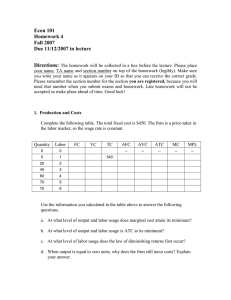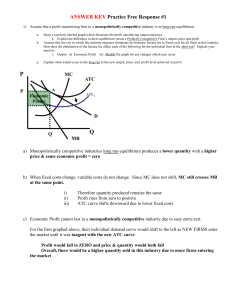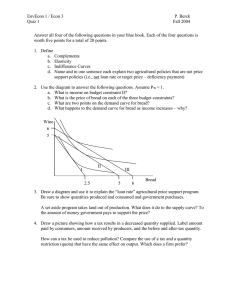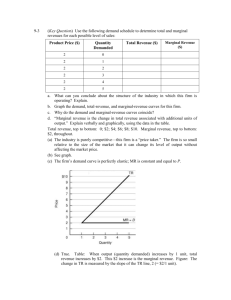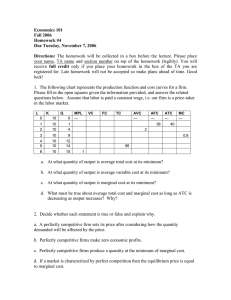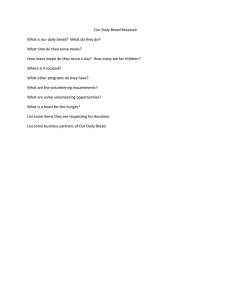Econ 101 Homework 4 Fall 2007 Due 11/12/2007 in lecture
advertisement
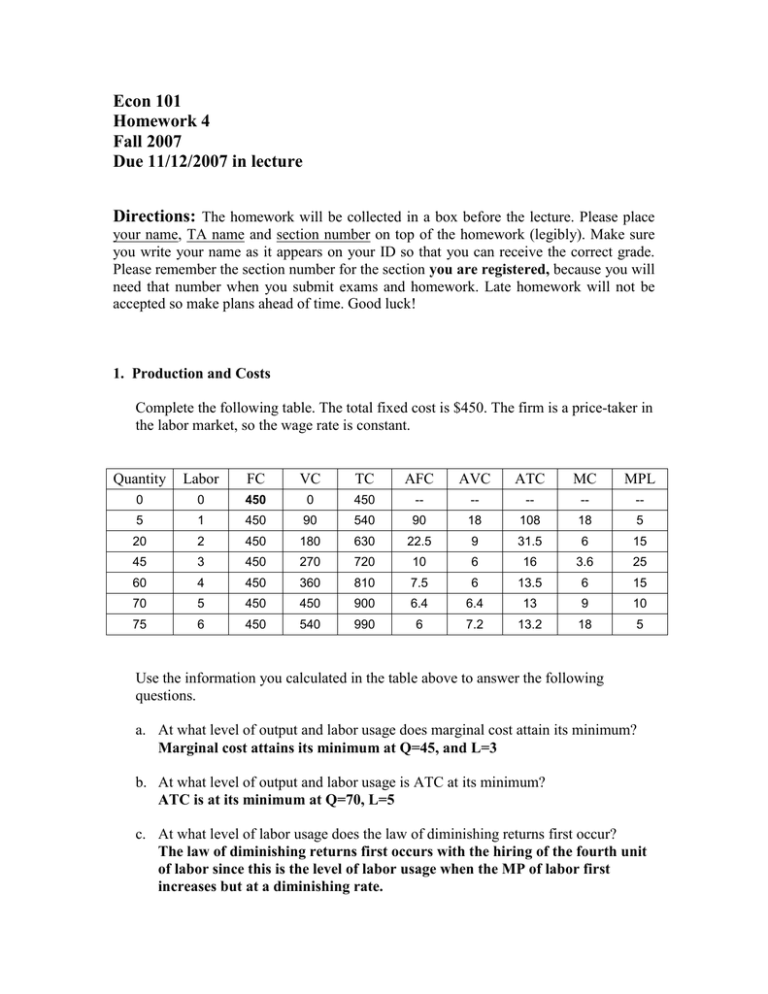
Econ 101 Homework 4 Fall 2007 Due 11/12/2007 in lecture Directions: The homework will be collected in a box before the lecture. Please place your name, TA name and section number on top of the homework (legibly). Make sure you write your name as it appears on your ID so that you can receive the correct grade. Please remember the section number for the section you are registered, because you will need that number when you submit exams and homework. Late homework will not be accepted so make plans ahead of time. Good luck! 1. Production and Costs Complete the following table. The total fixed cost is $450. The firm is a price-taker in the labor market, so the wage rate is constant. Quantity Labor FC VC TC AFC AVC ATC MC MPL 0 0 450 0 450 -- -- -- -- -- 5 1 450 90 540 90 18 108 18 5 20 2 450 180 630 22.5 9 31.5 6 15 45 3 450 270 720 10 6 16 3.6 25 60 4 450 360 810 7.5 6 13.5 6 15 70 5 450 450 900 6.4 6.4 13 9 10 75 6 450 540 990 6 7.2 13.2 18 5 Use the information you calculated in the table above to answer the following questions. a. At what level of output and labor usage does marginal cost attain its minimum? Marginal cost attains its minimum at Q=45, and L=3 b. At what level of output and labor usage is ATC at its minimum? ATC is at its minimum at Q=70, L=5 c. At what level of labor usage does the law of diminishing returns first occur? The law of diminishing returns first occurs with the hiring of the fourth unit of labor since this is the level of labor usage when the MP of labor first increases but at a diminishing rate. d. When output is equal to zero units, why does the firm still incur costs in the short run? Explain your answer. In the short run, the firm still incurs costs even though its production is equal to zero units because it still has fixed costs. It cannot get rid of its capital instantaneously so it will continue to have these costs even though it is not producing any output. e. As output increases, why does AVC first decrease, but then eventually increase? Explain your answer. AVC eventually increases due to diminishing returns to labor: as additional units of labor are hired the amount of capital per unit of labor decreases until eventually the additional units of labor are less productive and hence, this leads to rising average variable costs of production. f. Suppose the price of output is $20, fill in the following table using the information you gathered in the above table. Quantity 0 5 20 45 60 70 75 MC --18 6 3.6 6 9 18 TR --100 400 900 1200 1400 1500 TC 450 540 630 720 810 900 990 Profit = TR - TC -450 -440 -230 180 390 500 510 2. Perfect Competition Consider a competitive industry with a large number of firms. Assume that all the firms have identical cost functions. Suppose that initially the demand curve for this industry is given by Q = 52 – P where Q is the market quantity and P is the market price. Furthermore an individual firm’s total cost and marginal cost are given by the following equations: TC = q2 + 1 MC = 2*q where q is the quantity supplied by the firm. a. What is the breakeven price for this firm? ATC is at its minimum when ATC=MC, q=1, ATC=MC=2. So the breakeven price for this firm is 2. b. At the long-run profit maximizing level of output for the firm (i.e. that level of output where MR = MC = min ATC), what will be the equilibrium output in this industry? The equilibrium level of output in the industry can be found by using the market price of 2 in the market demand curve: thus, P = 52- Q gives us Q = 50. c. What will be the equilibrium output of each firm in the long-run if each firm is identical and each firm is profit maximizing? q=1 d. What will be the equilibrium number of firms in this industry in this long-run equilibrium? The equilibrium number of firms in this industry will equal the total level of production in the market divided by the level of production of a single firm. At a price of 2, we know that the total production in the market is 50 units since Q = 52 – P. And, if each firm produces one unit then it will take fifty firms to produce 50 units. e. Now suppose the government levies an excise tax of $2 on consumption of this good. What will be the equilibrium number of firms? What will be the long-run equilibrium price? The market demand function becomes: Q=50-P when the excise tax is imposed on consumers. Since the cost functions have not changed, the longrun equilibrium price remains 2. The number of firms is equal to the equilibrium market quantity divided the individual firm’s level of production or 48/1 or 48 firms. f. Return to the original situation and now suppose that due to environmental legislation, the fixed cost of production in every firm increases from 1 to 4. What is the new total cost function? (Marginal cost remains the same). TC = (q)2 + 4. g. Suppose the market price is equal to $2 per unit. How do short-run profits change due to the environmental legislation in part (f)? To answer this question you will first want to figure out the profit maximizing level of output for the firm, then check to make sure that the price of $2 is sufficient to cover the firm's AVC since the firm will choose to shut-down in the short run if it cannot cover its AVC. Then, if the firm does produce you can figure out the firm's short-run profits by calculating the difference between its total revenue and its total cost. In the short run, equilibrium price, and therefore the MR, will still be $2 and the equilibrium output for a representative firm will be 1 unit. The AVC cost of producing one unit is equal to 1 and the market price is greater than this so the firm will choose to produce in the short run since it is covering its variable cost of production. The firm's total revenue is equal to 2 while its total cost is equal to 5, so the firm is making a negative economic profit, or a loss, of 3 in the short run. h. What do you anticipate will happen in the long-run in this market and what will be the effect of this change on long-run profits? In your answer make sure you identify the level of long-run profits for a representative firm, the long-run level of output for a representative firm, the long-run equilibrium price level, the market level of output, and the number of firms now producing in this market. Since firms are making losses in the short run, one can expect the exiting of firms in the long-run until economic profits return to 0. The exiting of firms will cause the market price of the good to rise until it reaches the breakeven point at a price of 4 where each remaining firm is producing 2 units of output. At a price of 4 there will be 48 units of the good produced by 24 firms. Thus, relative to the initial situation 26 firms will have exited the market. To see where these answers come from here is a more detailed description: Recall that in the long run each firm will produce at its breakeven point where its ATC curve intersects its MC curve. Thus, to find the ATC curve you will need to divide TC/Q to get ATC = q + (4/q). Setting this equal to MC you will have q + 4/q = 2q. Solving for q you will get q = 2. Plugging q = 2 into the MC equation you can calculate the MC as equal to 4. This implies that the market price is also 4. Using this market price and the market demand equation you can calculate the market quantity as Q = 48. equilibrium number of firms is equal to the equilibrium market quantity divided by the level of production of a representative firm or 48/2 = 24 firms. 3. Income effect and substitution effect Sally only consumes bread (x) and soda (y). Her indifference curves take the form x*y = c where x is the number of units of bread, y is the number of units of soda and c is the total level of utility. Sally’s income is $16. When the price of bread is $4 (Px=$4) and the price of soda is $1 (Py=$1), Sally’s optimal choice is on indifference curve x*y = 16. a. Fill in the following table based upon the equation xy = 16 where x is the number of units of bread and y is the number of units of soda. X 1 2 4 Y 16 8 4 8 16 2 1 b. Draw the graph placing bread on the horizontal axis and soda on the vertical axis. How many units of bread and sodas does Sally consume given these prices? What is her MRS between bread and soda at her optimal consumption bundle? Sally will consume 2 units of bread and 8 units of sodas. Her MRS between bread and soda equals the price ratio=4 Now the price of bread falls to $1. Sally’s new optimal choice is on indifference curve x*y=64. c. Fill in the following table based upon the equation xy = 64 where x is the number of units of bread and y is the number of units of soda. X 1 2 4 8 16 32 64 Y 64 32 16 8 4 2 1 d. What is Sally’s optimal consumption bundle under the new prices? And what is her MRS between bread and soda at the new optimal consumption bundle? (Hint: you may want to draw in the new budget line and the new indifference curve on your original graph.) At the new prices, Sally will consume 8 units of bread and 8 units of sodas. Her MRS between bread and soda equals the price ratio=1. e. What are the substitution effect and income effect for the change in Sally’s consumption of bread? Illustrate them on your graph, and calculate the change in bread consumption due to the substitution effect and the change in bread consumption due to the income effect. The change from point A to B is substitution effect. The change from point B to C is income effect. For bread, substitution effect=4-2=2, income effect=84=4 f. Is bread a normal good or an inferior good for Sally? Is soda a normal good or an inferior good for Sally? They are both normal goods. Soda 16 A C 8 B 4 2 4 8 16 Bread
